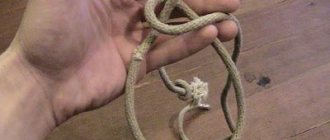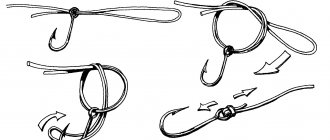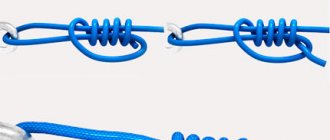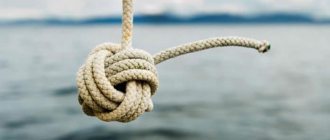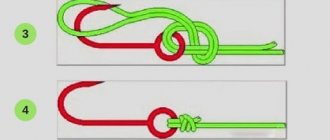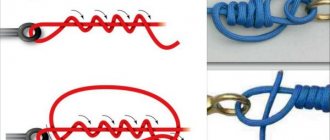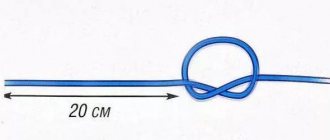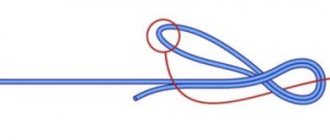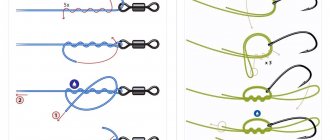Figure Eight Knot - This is a simple knot for creating a non-tightening loop. Used in fishing and mountaineering. It has several names: guide eight, single eight, double eight and counter.
In the article we will figure out how to knit a figure eight correctly so that the loop does not tighten and we will analyze all the varieties of this connection, their pros and cons. Using 6 knitting patterns, you will understand how to tie a figure-eight loop firmly attached to the fishing line, tie a hook or connect a leash to a thicker fishing line. We also gave examples of analogue units that have their own disadvantages, but also advantages.
Types of knot
You will see that the figure eight knot can be used both for tying loops and for tying hooks, baits, various elements with holes, as well as for tying 2 pieces of fishing line or cord. But this knot copes best with loose loops. All purposes are rather far-fetched and it is much more correct to use other, simpler and more reliable knots for hooking and connecting fishing lines.
Creating a loop
Classic (single eight or conductor eight). It is used both in fishing and in mountaineering. A strong knot that creates a non-tightening, stationary loop. Those. you can try to make a loop and then pull both ends of the line coming out of it - you will not be able to tighten the knot. Although there are no connections with 100% strength, and by experimenting, you will find a type of fishing line or cord that can still be tightened if you really want to. For these types of fishing lines (cords) there is a double figure eight. More about her later.
Knitting pattern for a Figure Eight knot to create a loop
Nine (double eight). Almost identical to single, but complicated by one additional step when tying. Stronger on stiffer types of line such as fluorocarbon.
Double figure eight with two loops. A more complicated version is made to create two loops at once with one knot.
Step 1. First make a loop from the double cord, then a second. And pass the middle part of the first loop into the second.
Step 2. Place the loop (number 1 in the image) over the loop number 2.
Step 3. Tighten the knot, pull immediately on 2 loops and two pieces of cord coming out of the knot at the bottom.
Step 4. Double eight is ready. If you use fishing line, be sure to wet it before tightening.
Tying a hook
Fishing. Here the node was simply lucky to be called an eight. There is no need to use such a knot on hooks; there are knots that are more reliable and easier to tie. Nevertheless, it would be wrong not to mention this variety.
Tying two fishing lines (cords)
Counter figure eight - a knot for tying two fishing lines together. As you can see in the diagram, it is indeed possible to tie 2 cords or 2 pieces of fishing line together using a classic figure-eight knot, but the feasibility is very low. The knot is more difficult to knit than the Bloody one and is less durable in this particular connection. And if you need to tie 2 pieces of fishing line of different diameters, then the Carrot knot is even better.
Step-by-step pattern for knitting a counter figure eight knot
Temporarily strengthening a damaged cord
The multiple figure eight is a sea knot that is knitted completely differently than the classic fishing and mountaineering eights. Designed to strengthen a weakened or damaged cord into a knot to prevent it from breaking. It can also be used for deliberately thickening cords or ropes, for example, for tying a handle for a sled.
How to knit a reverse figure eight knot. Figure Eight Knot – 6 knitting patterns and step-by-step instructions
People who use this node have good reasons for doing so. The Figure Eight Knot has its own motto: it is strong, easy to tie and easy to test. Fishermen also often use someone else's invention for their own purposes. However, many argue that a knot is easy to tie, but without outside help you can’t untie it back.
Node efficiency: 80%
History of the Eight Node
The history of the Eight knot is still unknown, as is its inventor. We only know that it has come down to us from very ancient times, since archaeologists often find it during excavations of ancient buildings and villages. Two more names for this knot are also known: Savoy or Flemish knot.
What is the Figure Eight knot used for?
The figure eight is a type of locking knot that is most commonly used in sailing and rock climbing. Rescue services can also use the Eight. Other purposes for which the Eight can be used include boating, tying up baby swings, tying ponytails, mooring, and it is also effectively used for making macramé jewelry, bracelets, and decorative napkin decoration.
Purpose
Figure eight knots are knitted for 4 purposes: tying a loose loop, tying hooks and pieces of fishing line, strengthening damaged areas. Looking at the table below you can understand why you need to use the figure eight.
| Strength | Easy knitting | |
| No-tightening loop | 5 / 5 | 5 / 5 |
| Tying hook | 3 / 5 | 3 / 5 |
| Tying fishing lines (cords) together | 3 / 5 | 3 / 5 |
| Strengthening a damaged section of cord (sea knot) | 4 / 5 | 2 / 5 |
I do not recommend tying hooks with this knot, because in this connection the line has too little contact with the hook in the knot, this reduces the strength of the knot. And tying this knot on small hooks is almost impossible. As for tying two cords (fishing line) - the same thing. There is not enough more contact between the two segments in the node. This reduces its strength. It will stretch easily.
Advantages and disadvantages of a double sea knot
In general, the list of advantages is significantly ahead of the list of disadvantages, which is understandable why.
Advantages of a simple double bayonet:
- does not interfere with pairing;
- adjustable unit;
- safe to use;
- universal;
- connects quickly.
There is only one drawback - the knot is very difficult to untie, especially when there is an additional load. Before you untie it, you need to loosen the tension.
Instructions for knitting a figure eight step by step
Let's look at the most important figure eight knot to create a strong, non-tightening loop step by step.
Step 1. Place the fishing line (or cord) so that it forms a loop.
Step 2. Roll the double line to create another loop. And then bring the tip of the main first loop behind the body of the second.
Step 3. Again, take the main loop between two fingers and thread it through the resulting hole, facing inward.
Step 4. If you look closely, you will notice that you get a figure-eight shaped knot. Pull the loop and both ends of the fishing line in different directions, first moistening the knot with liquid so that it does not burn out during strong tightening.
Step 5. In front of you is a finished loop, connected with a figure eight knot.
In what cases should the figure eight be used?
Since there are several varieties, the scope of this unit is very wide.
- For forming fixed and movable loops.
- For tying hooks, weights, feeders, bait and other equipment to the end of the main line.
- For connecting the main line with the leash on float rigs.
- For connecting the ends of fishing line or braid
- To increase the total length of the fishing line.
For all these purposes, the figure eight knot or one of its variations is successfully used.
Advice! World champion in feeder fishing Alexey Fadeev advises using this type of knot in almost all cases.
Advantages and disadvantages
- Easy to knit.
- Allows loops not to tighten, even on fluorocarbon fishing line, although it is not intended for critical knots.
- Tear-resistant.
- It is not suitable for winding it onto the spool of a spinning reel (the fishing line will still cling to it).
- Problems may arise on lines with a diameter of up to 0.1 mm. Use double eight.
- Ideal only for creating loops. For hooks, tying lines - it is difficult and does not hold the load so well.
- To tie fishing lines together, a variation of the “counter figure eight” is used, which is not suitable for fishing lines that have only one free end. You will not be able to tie your main line on the feeder gear with this knot if it suddenly breaks a few meters from the equipment. A repeated recommendation is to use a blood knot to tie two fishing lines.
Don't be alarmed by the fact that there are more minuses than pluses. All of the above disadvantages only emphasize that you need to use this knot exclusively for knitting loops.
How to tie a figure eight knot
The knot is quite simple, so to understand how to tie a figure eight, just look at the diagram below.
- First you need to make a regular loop by connecting the two ends of the fishing line together. At the base of the loop, you need to overlap its ends on top of each other. At the same time, its lower part is wound behind the upper one, drawing the number “eight”.
- After inserting the wound end into the loop, the desired figure-eight fishing knot is obtained.
- By tightening the loop, you will create the strongest and most reliable connection that will definitely withstand any load.
Loop organization diagram
In order to learn how to perform the figure-eight fishing knot properly, without leaving any slack in the end, you need to work a little. Practice will allow you to perfect the line attachment and loop creation. But the time spent will not be in vain; such a skill will always be useful not only when fishing, but also in everyday life.
The figure eight fishing knot is recommended to be used exclusively for monofilament and braided line. The process of its creation is very simple, and therefore even an amateur can do it. Whereas in terms of strength, this knot is not much different from the main fishing line, amounting to almost 93%.
Scheme for tying two fishing lines in a figure eight pattern:
Tying two fishing lines with a figure eight knot
Demonstration of organizing a loop on a fishing line. The video well illustrates the ease of making this unit:
Alternative nodes
Oak loop.
Despite such an unpopular name, this is the same knot that is familiar to all of us since childhood. By looking at the step-by-step knitting instructions in the photo below, you will be convinced of this. It cannot replace the figure eight, since such a loop, with strong tension in the lines in different directions, will definitely pull together to one point. However, on thick cords and ropes this effect is much less noticeable.
Knitting pattern for oak loop
Vein loop. This is simply an improvement on the oak loop with just one extra turn in the same direction. Like the simplified form, it is more suitable for ropes and cords. But if you don’t need a non-tightening connection, then this is a good, reliable option.
Vein loop knitting pattern
Sliding loop. It is a tourist knot for creating a tightly tightened loop. The harder you pull, the stronger it tightens.
Sliding loop knitting pattern
Let me remind you that the above alternative nodes are of much lower quality than the figure eight. The knots and loops on them can move up and down the line, if this suits you, then no problem. For hooks, I recommend any of the other popular ones: bloody, palomar, spindle. For tying two lines - carrot and bloody.
Write in the comments if you know other varieties of figure eight. In what cases do you knit this particular knot, and how does it help you in fishing and tourism.
Similar nodes
Eight is the highest quality and most reliable fastening option. At the initial stage, we recommend mastering the single or double version. A certain part of fishermen uses alternative types of connections, which will be discussed below.
Vein loop
Fishermen claim that this is an oak loop, supplemented by one turn. Moreover, in the same direction. This option is more suitable for attaching ropes and cords.
Stages of creating a vein loop
sliding
Mounting option for hiking trips. Sliding is used as a fixed, tightening option. Peculiarity:
Photo of step-by-step assembly
It is important to consider that the alternative knots we are considering are of lower quality than the traditional 8. On these designs, the loops can move up and down the line.
If this situation does not bother you and suits you, then everything is fine. To attach hooks, it is recommended to use more popular options, such as:
- Bloody knot.
- Palomar.
- Spindle.
For the simultaneous installation of two ropes, a bloody fisherman's rope, or a structure called a carrot, is best suited.
Oak loop
The name is unpopular. Although he is the one many have known since childhood. Just look at the photo and see for yourself that the author’s words are correct.
The design is not capable of replacing 8. Since when the structure is tensioned (tightening the two ends of the fishing line in different directions), the displacement always occurs in the direction of one point. This effect is clearly more noticeable on thinner ropes than on thicker cords.
Oak assembly technique
Finally
There are many combinations for crocheting. There are so many of them that it is impossible to list them in one article. Therefore, we are considering options for introducing our readers to other editing methods, good luck.
What does the Bunny Ears knot look like?
Hare ears fall under the category of loops and are also a type of knot that forms two parallel loops and resembles a figure eight loop or hare ears. It's really based on a simple eight loops. At the same time, the Double Conductor is not at all similar to the usual Conductor, however, the related name has been preserved.
The bunny's "ears" can be adjusted so that the fastening of the loops is perfectly aligned, giving a more sophisticated look to the knot.
Compared to some other double loop knots, such as the French Bowline, the Double Wire is very stable and reliable. It is unlikely to slip so that one loop becomes larger at the expense of another loop.
The hare's ears are described primarily as an anchor or anchoring knot and have the following characteristics:
- aligned;
- excess;
- non-stretchable;
- strong;
- operational.
Lastly, this knot is simple and elegant.


